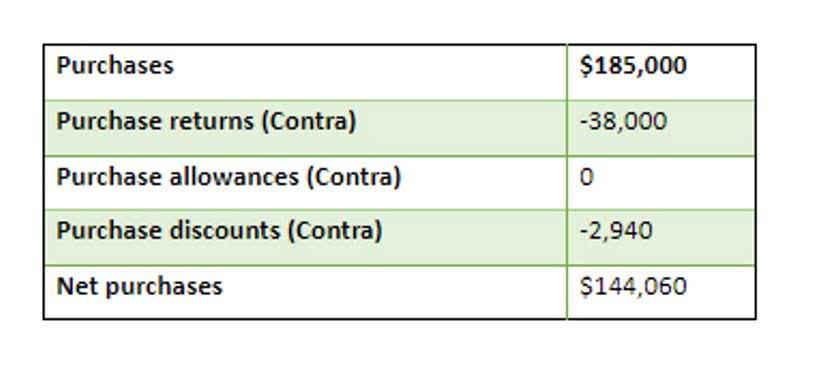Purchase allowance definition

As mentioned, these transactions do not impact the purchases account. Nonetheless, it is crucial to understand how a company records the purchase of products or services. Some companies may keep two separate accounts for purchase returns and purchase allowances. However, others may maintain both of them under the same account due to their similar nature. Regardless of its presence in the books, both accounts reduce the purchases figure in the financial statements. However, they do not directly impact the purchases account in the general ledger.
Similarly, purchase allowances are discounts received for goods already recorded in the accounts. Both of these accounts represent a reduction in a company’s purchase expense. In accounting, both purchase returns and purchase allowances are contra expense accounts. A contra expense account is an account in the general ledger paired and offset with a specific expense account.
The allowance for doubtful accounts is used to anticipate that some accounts receivable will not be collected. GAAP states that the conditions under which receivables exist usually involve some degree of uncertainty about their collectability, in which case a contingency exists. The loss from uncollectible receivables needs to be reflected on the income statement and balance sheet in order to present a fair depiction of the state of the company.
How to record Purchase Returns and Allowances?
This compensation may include cash return or reduction in balance with the supplier. If $2,100 out of $100,000 in credit sales did not pay last year, then 2.1% is a suitable sales method estimate of the allowance for bad debt this year. This estimation process is easy when the firm has been operating for a few years. New businesses must use industry averages, rules of thumb, or numbers from another business. A purchase allowance is a reduction in the buyer’s cost of merchandise that had been purchased. The purchase allowance is granted by the supplier because of a problem such as shipping the wrong items, an incorrect quantity, flaws in the goods, etc.
In this case, ABC Company sells 10,000 units of its product at $10 each, with a 10% purchase discount and a 2% purchase allowance for customers. The original purchase must be reduced on the books by the amount returned by using the purchases returns and allowances account. Businesses use discounts and allowances to encourage customers to buy from them or to pay an outstanding bill sooner. Incentives used to motivate sales are called discounts while those used to motivate payments are called allowances (which apply only to purchases made on credit). Also a general ledger account in which the purchase allowances are recorded under theperiodic inventory method.
Purchase returns and allowances, as stated priorly, have to be recorded on a financial sheet known as a contra revenue account. The supplier will combine the debit balance in its Sales Allowances account with the credit balance in its Sales account to arrive at its net sales. A purchase allowance is a reduction in the price of goods or services after delivery. It is not a reduction in the price of goods or services before the delivery. Similarly, it does not offer an early settlement discount, excluding it from cash discounts.
When a company purchases goods or services, it uses the following journal entries to record it. All the above reasons can give rise to a purchases return for companies. Sometimes, however, companies may not return goods to suppliers. For example, the goods may be faulty but still in an acceptable condition. Nonetheless, companies will require compensation in exchange for accepting below standard or faulty goods.
- There are several examples of purchase returns and allowances in daily business.
- The excerpt below shows how purchase discounts and allowances are deducted from gross revenue on the income statement of a retail or wholesale company.
- In purchase returns, a customer returns a defective product they had earlier purchased to the seller for a full or partial refund.
- The main purpose of the accounting concept for purchase returns is to make it look like there was never a purchase in the first place.
The Allowance for Doubtful Accounts is used when Bad Debt Expense is recorded prior to knowing the specific accounts receivable that will be uncollectible. For example, a company might have 500 customers purchasing on credit and they owe the company a total of $1,000,000. The $1,000,000 is reported on the company’s balance sheet as accounts receivable. An allowance for bad debt is a valuation account used to estimate the amount of a firm’s receivables that may ultimately be uncollectible. This is recorded as a debit to the bad debt expense account and a credit to the allowance for doubtful accounts.
What is a purchase allowance?
The basic idea is that the longer a debt goes unpaid, the more likely it is that the debt will never pay. In this case, perhaps only 1% of initial sales would be added to the allowance for bad debt. However, 10% of receivables that had not paid after 30 days https://www.online-accounting.net/home-office-expense-home-office-tax-deductions-for/ might be added to the allowance for bad debt. A bad debt expense is recognized when a receivable is no longer collectible because a customer is unable to fulfill their obligation to pay an outstanding debt due to bankruptcy or other financial problems.
You may not even be able to specifically identify which open invoice to a customer might be so classified. A reduction in the cost of goods purchased that is granted by a supplier without the physicalreturn of the goods. Once the company establishes the quality and quantity of goods it needs, it will place an order with a supplier. For some companies, the process may also involve looking for various suppliers and selecting the best option. However, other companies may have a pre-approved list of suppliers from which they purchase goods. Overall, ABC Co. presented its net purchases in its financial statements as follows.
What is Accounts Payable? Definition, Recognition, and Measurement, Recording, Example
Since companies already record the purchase expense, they cannot reduce it unless due to an error. Therefore, they need the purchase returns and allowances accounts to offset it. The sales method applies a flat percentage to the total dollar amount of sales for the period. For example, based on previous experience, a company may expect that 3% of net sales are not collectible. If the total net sales for the period is $100,000, the company establishes an allowance for doubtful accounts for $3,000 while simultaneously reporting $3,000 in bad debt expense. If the following accounting period results in net sales of $80,000, an additional $2,400 is reported in the allowance for doubtful accounts, and $2,400 is recorded in the second period in bad debt expense.
More about purchase discounts and allowances
The credit to purchases returns and allowances reduces the value of the defective bikes in the purchases account. In purchase returns, a customer returns a defective product they had earlier purchased to the seller for a full or partial refund. In a normal purchase transaction, the customer’s money or payment is recorded under debit. Therefore, ABC Co. returned those goods to the relevant suppliers.
In returns and allowances accounting, this line item is presented as a subtraction from the gross sales line item. It is used to decrease sales by the number of product returns from customers and sales allowances granted. In the income statement, it comes operating expenses before a net sales line item, which is a computation that aggregates the gross sales line item and the negative amount in the sales returns and allowances line item. The above explanation provides a basis to record purchase returns and allowances.
It eliminates the purchase trail and the purchase accounting in the debit to smoothen out the transaction. The allowance can accumulate across accounting periods and may be adjusted based on the balance in the account. Two primary methods exist for estimating the dollar amount of accounts receivables not expected to be collected.












